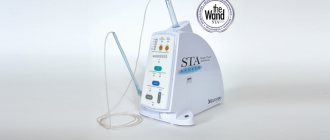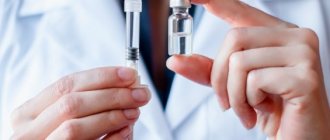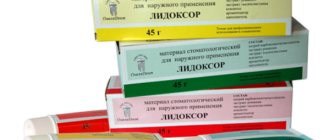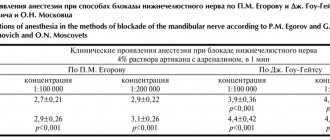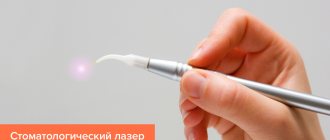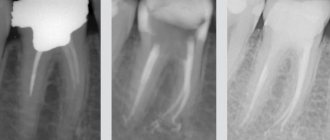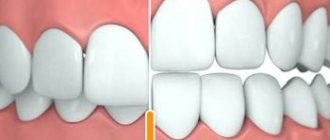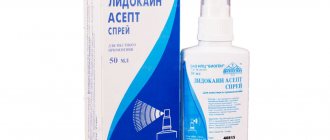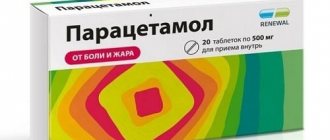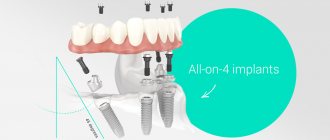Anesthesia in dentistry
The best drugs for local anesthesia in dentistry
As we said, most often in dental clinics drugs based on articaine are used, in particular Ultracaine or Ubistezin. Now, taking into account the information presented, it is time to dwell in more detail on the advantages of such anesthetics.
Artikain
Modern local anesthesia in dentistry is unthinkable without articaine. It is this anesthetic that has a minimal ratio of toxicity and analgesic activity. In other words, among the most effective remedies, it is the least toxic.
Articaine is actively used for infiltration and conduction anesthesia. It is also used for intraosseous anesthesia before dental operations. But the surface anesthetic effect of articaine is not typical, which is why it is not suitable for applications.
The advantage of articaine is its high effectiveness against inflammation. (The inflammatory process reduces the effect of many drugs). This feature allows the use of Ultracain or Ubistezin in the treatment of purulent-inflammatory diseases of teeth and periodontium.
Due to its low toxicity, articaine is the best remedy for pediatric dentistry, the elderly, and patients with diseases of the hepatobiliary and urinary systems. Can be used while breastfeeding. Articaine practically does not penetrate into breast milk, and if it is found in it, it is in extremely low concentrations that have no clinical significance.
Can articaine be used during pregnancy? Studies have shown that although articaine crosses the placental barrier, it does not have a toxic or mutagenic effect on the fetus. Articaine can be used during pregnancy.
Lack of articaine in the average duration of action. It is quickly absorbed into the blood, quickly destroyed and excreted in the urine. This is partly due to the fact that articaine, like many local anesthetics, dilates blood vessels. For this reason, articaine is often used together with vasoconstrictors, which are already included in the drug. For example:
- Ultracain DS Forte, Ubistezin Forte contain adrenaline in a concentration of 1:100,000 (average concentration).
- Ultracain DS, Ubistezin contain adrenaline in a concentration of 1:200,000 (low concentration).
What if the patient belongs to a risk group and cannot be injected with an anesthetic with adrenaline? In this case, you need to use Ultracaine D - a drug with articaine without a vasoconstrictor component.
During pregnancy, it is recommended to use articaine in combination with adrenaline in low concentrations (Ubistezin, Ultracaine DS). Some experts believe that it is better not to use vasoconstrictors at all when treating pregnant women. Which option is better? The choice must be made taking into account individual characteristics. A woman should consult with specialists, including a gynecologist who monitors the pregnancy.
Lidocaine
Lidocaine is another popular and widely used drug, despite the fact that it is 2 times more toxic than procaine. The advantage of lidocaine is its average duration of action and more pronounced effect (it is 4 times stronger than procaine). The problem is that lidocaine dilates blood vessels, which requires the simultaneous use of high doses of a vasoconstrictor drug. For this reason, lidocaine is rarely used for conduction or infiltration, but is often used for superficial anesthesia.
Can lidocaine be used during pregnancy? We have already mentioned one drawback - the drug requires the use of adrenaline in high concentrations. The second disadvantage of lidocaine is that it is toxic, crosses the placenta and accumulates in the fetal liver. Considering the above, local anesthesia with lidocaine is contraindicated for pregnant women.
Mepivacaine
A unique drug, because it is the only anesthetic for local anesthesia with a vasoconstrictor effect. This feature allows the use of mepivacaine without a vasoconstrictor, which makes it the best tool for providing anesthetic benefits to patients at risk (diabetes, thyroid disease, hypertension and other cardiovascular diseases).
Mepivacaine is actively used for infiltration and conduction anesthesia. It is contraindicated during pregnancy because it penetrates the placental barrier and narrows the uterine arteries, which can lead to fetal hypoxia.
Anesthesia in pediatric dentistry
The problem of anesthesia in pediatric dentistry is quite acute, since it is psychologically and physically difficult for young patients to withstand a long treatment procedure. On the one hand, they are frightened by the noise of dental instruments, on the other hand, it is simply difficult for them to sit still for 40-60 minutes. In this regard, instead of local anesthesia, the dentist may recommend anesthesia.
Anesthesia in pediatric dentistry is carried out using a modern drug - Sevoran. Unlike the previously popular ZAX (nitrous oxide-oxygen mixture), Sevoran combines not only high efficiency (sufficient depth and duration of medicated sleep), but also maximum safety and a very “clean” recovery from anesthesia. After waking up, the child feels great; headaches, nausea or dizziness are extremely rare.
You can learn more about the methods of providing anesthesia in pediatric and adult dentistry at a consultation with a medical dentist.
Make an appointment
Experience in the clinical use of local anesthetics based on mepivacaine
A. V. Kuzin
Candidate of Medical Sciences, dental surgeon of the Federal State Institution "Central Research Institute of Infrastructure and Maxillofacial Surgery" of the Ministry of Health of the Russian Federation, consultant physician at 3M ESPE on pain management in dentistry
M. V. Stafeeva
dentist-therapist, private practice (Moscow)
V. V. Voronkova
Candidate of Medical Sciences, Dentist-Therapist, Department of Therapeutic Dentistry, Clinical Diagnostic Ministry of Health of Russia
Often in clinical practice there is a need to use short-acting anesthetics. There are many low-volume dental procedures that require pain relief. The use of long-acting anesthetics is not entirely legal, since the patient leaves the dentist with numbness in a certain area of the oral cavity lasting from 2 to 6 hours.
Taking into account the labor and social load on the patient, the use of short-acting anesthetics is justified, which can reduce the duration of soft tissue numbness to 30-45 minutes. Today in dentistry, local anesthetics based on mepivacaine meet these requirements.
Mepivacaine is the only amide anesthetic that can be used without the addition of a vasoconstrictor. Most amide anesthetics (articaine, lidocaine) dilate the blood vessels at the injection site, which leads to their rapid absorption into the bloodstream. This shortens the duration of their action, which is why dosage forms of anesthetics are available with epinephrine. In the Russian Federation, lidocaine is produced in ampoules without vasoconstrictors, which requires its dilution with epinephrine before use. According to modern standards of pain management in dentistry, the preparation of a local anesthetic solution by staff is a violation of the anesthesia technique. 3% mepivacaine has a less pronounced local vasodilator effect, which allows it to be effectively used to anesthetize teeth and soft tissues of the oral cavity (Table No. 1).
The duration of action of mepivacaine-containing anesthetics (mepivastezin) varies in individual areas of the oral cavity. This is due to some features of its pharmacological action and features of the anatomy of the oral cavity. According to the instructions of the local anesthetic, the duration of anesthesia for the dental pulp is on average 45 minutes, anesthesia for soft tissues - up to 90 minutes. These data were obtained as a result of an experimental study in practically healthy patients during anesthesia of single-rooted teeth, mainly in the upper jaw. Naturally, such studies do not reflect real clinical conditions in which a dentist is faced with inflammatory phenomena in tissues, chronic neuropathic pain, and the individual characteristics of the patient’s anatomy. According to domestic scientists, it was found that the average duration of dental pulp anesthesia when using 3% mepivacaine is 20-25 minutes, and the duration of soft tissue anesthesia depends on the volume of anesthetic administered and the anesthesia technique (infiltration, conduction) and is 45-60 min.
An important issue is the speed of onset of local anesthesia. Thus, when using 3% mepivacaine, the rate of onset of dental pulp anesthesia is 5-7 minutes. Therapeutic dental treatment will be most painless for the patient from the 5th to the 20th minute after anesthesia. Surgical treatment will be painless from the 7th to the 20th minute after local anesthesia.
There are some peculiarities in the anesthesia of certain groups of teeth with 3% mepivacaine. Numerous studies have proven that it is most effective in relieving pain in single-rooted teeth. The incisors of the upper and lower jaws are anesthetized with infiltration anesthesia with 3% mepivacaine in a volume of 0.6 ml. In this case, it is important to take into account the topography of the apexes of the roots of the teeth and, accordingly, the depth of advancement of the carpule needle into the tissue. For anesthesia of canines, premolars and molars of the upper jaw, the authors recommend creating an anesthetic depot of 0.8-1.2 ml. Mandibular premolars respond well to anesthesia with 3% mepivacaine: submental anesthesia is performed in various modifications, where an anesthetic depot of up to 0.8 ml is created. It is important after submental anesthesia to apply digital pressure to the soft tissues above the mental foramen for better diffusion of the anesthetic. Infiltration anesthesia in the area of mandibular molars with 3% mepivacaine is ineffective compared to articaine. Anesthesia of mandibular molars with 3% mepivacaine is advisable only in patients with contraindications to the use of articaine-containing anesthetics with epinephrine: in these cases, mandibular anesthesia (1.7 ml of 3% mepivacaine) must be performed. Mandibular canines are also anesthetized with chin or mandibular anesthesia in patients with the contraindications described above.
As a result of many years of experience in the clinical use of mepivacaine, indications and clinical recommendations for its use have been developed. Of course, mepivacaine is not an “every day” anesthetic; however, there are a number of clinical cases when its use is most appropriate.
Patients with chronic general somatic diseases.
First of all, the use of mepivacaine is most justified in patients with cardiovascular pathology and restrictions on the use of a vasoconstrictor. If a low-traumatic intervention lasting less than 20-25 minutes is planned, there are indications for the use of 3% mepivacaine, which does not affect the patient’s hemodynamic parameters (BP, HR). If longer-term treatment or intervention is planned in the area of the mandibular molars, from a clinical point of view, the use of only articaine-containing anesthetics with a vasoconstrictor of 1:200,000 is justified.
Patients with a history of allergies.
There is a group of patients with bronchial asthma in whom the use of articaine with a vasoconstrictor is contraindicated due to the risk of developing status asthmaticus due to the preservatives contained in the carpule. Mepivacaine does not contain preservatives (sodium bisulfite), so it can be used for short-term interventions in this group of patients. For longer interventions in this group of patients, it is advisable to carry out dental treatment in specialized institutions under the guidance of an anesthesiologist. Mepivacaine can be used in patients with multivalent allergies and those allergic to a known anesthetic. Outpatient dental treatment for such patients is carried out after the conclusion of an allergist on the tolerability of the drug. According to the clinical experience of the authors of this article, the frequency of positive allergy tests for 3% mepivacaine is significantly lower in comparison with other carpulal anesthetics.
In therapeutic dentistry
mepivacaine is used in the treatment of uncomplicated caries: enamel caries, dentin caries. It is important to consider that the required duration of anesthesia is limited to the stage of preparation of hard dental tissues. After covering the formed cavity with adhesive material, further restoration will be painless. Accordingly, any planned invasive treatment should not exceed 15 minutes after the onset of anesthesia. Also, when planning treatment, one should take into account the low effectiveness of mepivacaine in anesthesia of canines and molars of the lower jaw with infiltration anesthesia and with intraligamentary anesthesia of the teeth of the lower jaw.
In surgical dentistry
mepivacaine is used for short-term surgical interventions. The greatest effectiveness was found when removing teeth with chronic periodontitis and when removing intact teeth for orthodontic indications. The role of mepivacaine in pain relief during surgical dressings is important. Often, the procedure for removing sutures, changing the wound covering in the tooth socket, and changing the iodoform dressing is painful for patients. The use of long-acting anesthetics is unjustified due to the subsequent long-term numbness of soft tissues, which can lead to self-injury of the surgical site when eating. In these cases, infiltration anesthesia is used in a volume of 0.2-0.4 ml of 3% mepivacaine, and for dressings after extensive surgical interventions (cystectomy, excision of soft tissue formations, removal of an impacted third molar), conduction anesthesia is performed. The use of mepivacaine during outpatient surgical dressings can reduce patient discomfort and stress.
Pediatric dentistry.
Short-acting anesthetics have proven themselves well when used in pediatric dentistry. When using mepivacaine, the dosage of this drug should be taken into account when performing local anesthesia in children. Mepivacaine is more toxic to the central nervous system than articaine because it is rapidly absorbed into the bloodstream. Also, the clearance of mepivacaine is higher than the clearance of articaine for several hours. The maximum dosage of 3% mepivacaine is 4 mg/kg of body weight for a child over 4 years of age (Table No. 2). However, in pediatric dentistry there are no indications for the use of such high volumes of anesthetic. According to modern safety standards, the dosage of 3% mepivacaine administered should not exceed half the maximum dose for the entire dental treatment. With this use, cases of local anesthetic overdose (weakness, drowsiness, headaches) in pediatric practice are excluded.
When using mepivacaine, cases of self-injury of the soft tissues of the oral cavity by a child after treatment at the dentist are practically excluded. According to statistics, up to 25-35% of preschool children injure the lower lip after treatment of the lower teeth, and in most cases this is associated with the use of long-acting anesthetics based on articaine with a vasoconstrictor. Short-acting local anesthetics can be used when sealing dental fissures, treating initial forms of caries, and removing temporary teeth. The use of mepivacaine in children with polyvalent allergies and bronchial asthma is especially justified, since the drug does not contain preservatives (EDTA, sodium bisulfite).
Pregnancy and breastfeeding.
Mepivacaine can be safely used in pregnant women during routine sanitation of the oral cavity at the dentist according to the indications described above. In most cases, 3% mepivacaine is used for short-term and minimally invasive interventions lasting up to 20 minutes. The second trimester of pregnancy is most favorable for treatment.
Mepivacaine can be used in breastfeeding women; it is found in mother's breast milk in concentrations that are insignificant for the child. However, the patient is recommended to refrain from feeding the child for 10-12 hours after anesthesia with 3% mepivacaine and for 2 hours after anesthesia with 4% articaine with epinephrine, which completely eliminates the effect of the anesthetic on the child.
conclusions
Thus, mepivacaine-containing anesthetics (Mepivastezin) have found their use in various fields of dentistry. For a certain group of patients, these anesthetics are the only drugs for local anesthesia due to general somatic features. As a short-acting anesthetic, the drug can be well used for minimally invasive short-term interventions.
Table No. 1. Features of the clinical use of 3% mepivacaine (Mepivastezin)
| The onset of anesthesia for single-rooted teeth is 5 minutes, for multi-rooted teeth - 7 minutes |
| Therapeutic invasive treatment is carried out from the 5th to the 20th minute after anesthesia; surgical treatment should be carried out from the 7th to the 20th minute after anesthesia |
| Does not affect the patient's hemodynamic parameters (BP, heart rate). Drug of choice in patients with relative contraindications to the use of vasoconstrictors |
| Indicated for patients with bronchial asthma, hypersensitivity to sulfites, polyvalent allergies |
Table No. 2. Dosage of 3% mepivacaine based on patient weight (adult/child)
| Weight | Mg | Ml | Carpools |
| 10 | 44 | 1.5 | 0.8 |
| 15 | 66 | 2.2 | 1.2 |
| 20 | 88 | 2.8 | 1.4 |
| 25 | 110 | 3.6 | 1.7 |
| 30 | 132 | 4.4 | 2.4 |
| 35 | 154 | 5.1 | 2.9 |
| 40 | 176 | 5.9 | 3.2 |
| 45 | 198 | 6.6 | 3.6 |
| 50 | 220 | 7.3 | 4.0 |
| Mepivacaine 3% without vasoconstrictor. Maximum dose 4.4 mg/kg; 3% solution in 1 carpule 1.8 ml (54 mg) | |||
